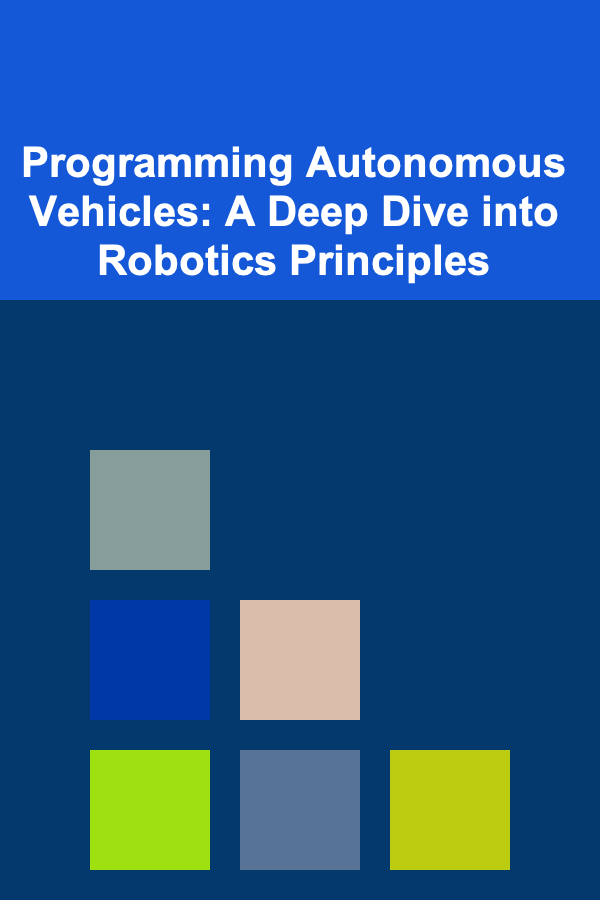
Programming Autonomous Vehicles: A Deep Dive into Robotics Principles
ebook include PDF & Audio bundle (Micro Guide)
$12.99$8.99
Limited Time Offer! Order within the next:

The development of autonomous vehicles (AVs) represents a significant leap in robotics and artificial intelligence. These self-driving cars promise to revolutionize transportation, offering increased safety, efficiency, and accessibility. However, creating a truly autonomous vehicle is a complex engineering challenge that requires the integration of numerous robotics principles, advanced algorithms, and robust software systems. This document delves into the core robotics principles underpinning the programming of autonomous vehicles, providing a comprehensive overview of the key components and challenges involved.
I. Foundational Robotics Principles for Autonomous Driving
At its core, an autonomous vehicle is a sophisticated robot navigating a complex and dynamic environment. The underlying principles that guide the development and programming of these vehicles stem directly from the field of robotics:
A. Perception: Seeing and Understanding the World
Perception is the cornerstone of autonomous driving. The vehicle must be able to accurately sense and interpret its surroundings to make informed decisions. This involves:
- Sensor Fusion: Autonomous vehicles rely on a suite of sensors to gather environmental data. These typically include:
- Cameras: Provide visual information, enabling object detection, lane keeping, traffic sign recognition, and semantic segmentation (understanding what each pixel in the image represents). Different camera types, such as monocular, stereo, and infrared, offer varying advantages.
- LiDAR (Light Detection and Ranging): Emits laser beams to create a 3D point cloud representation of the environment. LiDAR is crucial for accurate distance measurement and object localization, particularly in challenging lighting conditions.
- Radar (Radio Detection and Ranging): Uses radio waves to detect objects and measure their velocity. Radar is effective in adverse weather conditions like fog and rain, where cameras and LiDAR may struggle.
- Ultrasonic Sensors: Primarily used for short-range detection, such as parking assistance and obstacle avoidance at low speeds.
- Inertial Measurement Unit (IMU): Measures the vehicle's acceleration and angular velocity, providing information about its motion and orientation.
- GPS (Global Positioning System): Provides the vehicle's location coordinates. Often augmented with differential GPS (DGPS) for improved accuracy. The challenge lies in effectively fusing the data from these diverse sensors to create a coherent and reliable representation of the environment. Sensor fusion algorithms must handle sensor noise, calibration errors, and varying sensor modalities. Common techniques include Kalman filtering, Bayesian networks, and deep learning-based fusion methods.
- Object Detection and Classification: Identifying and categorizing objects in the vehicle's surroundings is critical. This includes detecting pedestrians, vehicles, cyclists, traffic signs, and other relevant elements. Deep learning models, particularly convolutional neural networks (CNNs), have revolutionized object detection, achieving high accuracy and real-time performance. Popular architectures include YOLO (You Only Look Once), SSD (Single Shot MultiBox Detector), and Faster R-CNN. The training of these models requires vast amounts of labeled data.
- Semantic Segmentation: Goes beyond object detection by classifying each pixel in an image, providing a detailed understanding of the scene layout. This is useful for identifying drivable areas, sidewalks, and other important features. Deep learning models based on fully convolutional networks (FCNs) are commonly used for semantic segmentation.
- Lane Detection and Tracking: Identifying and tracking lane markings is essential for lane keeping and navigation. Algorithms typically involve image processing techniques such as edge detection, Hough transforms, and Kalman filtering. Robust lane detection systems must be able to handle varying lighting conditions, occlusions, and damaged lane markings.
- Environmental Understanding: The goal is to build a comprehensive understanding of the vehicle's environment, including the location and behavior of other agents, the road geometry, and the presence of any potential hazards. This requires integrating information from multiple sensors and using advanced reasoning techniques.
B. Localization and Mapping: Knowing Where You Are and What's Around
Accurate localization and mapping are fundamental for autonomous navigation. The vehicle needs to know its precise location in the world and have a detailed map of its surroundings.
- Simultaneous Localization and Mapping (SLAM): SLAM algorithms allow the vehicle to build a map of its environment while simultaneously estimating its own location within that map. This is particularly useful in environments where GPS signals are unreliable or unavailable. SLAM techniques often rely on LiDAR or visual data. Common SLAM algorithms include Extended Kalman Filter (EKF) SLAM, Particle Filter SLAM, and graph-based SLAM. Visual SLAM (VSLAM) uses cameras as the primary sensor.
- High-Definition (HD) Maps: HD maps provide highly detailed and accurate representations of the road network, including lane markings, traffic signs, and other relevant information. These maps are created using specialized mapping vehicles equipped with high-precision sensors. HD maps serve as a crucial reference for localization and planning. However, relying solely on HD maps is not sufficient; the vehicle must also be able to perceive and react to changes in its environment.
- Sensor-Based Localization: The vehicle can estimate its location by comparing sensor data (e.g., LiDAR point clouds, camera images) to a pre-existing map or by matching features in the sensor data to known landmarks. This approach is often used to augment GPS-based localization. Techniques like Iterative Closest Point (ICP) are used to align sensor data with a map.
C. Planning and Decision-Making: Charting the Course
Once the vehicle has a clear understanding of its environment and its own location, it needs to plan a safe and efficient path to its destination and make decisions about how to navigate the road.
- Path Planning: Path planning algorithms generate a sequence of waypoints that guide the vehicle to its destination while avoiding obstacles. These algorithms must consider factors such as road geometry, traffic regulations, and the behavior of other agents. Common path planning algorithms include A*, Dijkstra's algorithm, and rapidly-exploring random trees (RRT). The planned path needs to be smooth and feasible for the vehicle to execute.
- Behavioral Planning: Behavioral planning involves making high-level decisions about the vehicle's actions, such as changing lanes, overtaking, or yielding to pedestrians. These decisions are based on the vehicle's understanding of the situation and its goals. Behavior trees and finite state machines are often used to represent behavioral plans.
- Decision-Making under Uncertainty: Autonomous driving involves navigating uncertain and unpredictable environments. The vehicle must be able to make decisions even when it has incomplete or noisy information. Probabilistic decision-making techniques, such as Markov decision processes (MDPs) and partially observable Markov decision processes (POMDPs), are used to model uncertainty and optimize decision-making. Reinforcement learning is also gaining popularity for learning optimal driving policies from experience.
- Trajectory Optimization: Trajectory optimization refines the planned path to ensure that it is smooth, safe, and dynamically feasible. This involves considering the vehicle's dynamics, such as its acceleration, braking, and turning radius. Optimization algorithms, such as quadratic programming, are used to find the optimal trajectory.
D. Control: Executing the Plan
The control system is responsible for executing the planned trajectory by controlling the vehicle's actuators, such as the steering wheel, throttle, and brakes.
- Vehicle Dynamics Modeling: Accurate vehicle dynamics models are essential for designing effective control systems. These models describe the relationship between the vehicle's inputs (e.g., steering angle, throttle position) and its motion (e.g., velocity, acceleration, yaw rate). Models can range from simple kinematic models to complex dynamic models that take into account factors such as tire slip and suspension dynamics.
- Low-Level Control: Low-level control systems are responsible for controlling the vehicle's actuators to track the desired trajectory. Common control techniques include PID control, model predictive control (MPC), and adaptive control. MPC is particularly well-suited for autonomous driving because it can explicitly handle constraints and optimize performance over a future time horizon.
- High-Level Control: High-level control systems manage the overall behavior of the vehicle, such as lane keeping, speed control, and collision avoidance. These systems often use hierarchical control architectures, where a high-level planner generates a desired trajectory, and a low-level controller executes that trajectory.
II. Key Algorithms and Technologies
The development of autonomous vehicles relies on a wide range of algorithms and technologies, including:
A. Deep Learning
Deep learning has revolutionized many aspects of autonomous driving, enabling significant improvements in perception, planning, and control.
- Convolutional Neural Networks (CNNs): Used for object detection, image classification, semantic segmentation, and other computer vision tasks.
- Recurrent Neural Networks (RNNs): Used for processing sequential data, such as time-series data from sensors or natural language instructions.
- Reinforcement Learning (RL): Used for learning optimal driving policies through trial and error. RL algorithms can be used to train the vehicle to perform complex maneuvers, such as merging onto a highway or navigating a busy intersection. Deep reinforcement learning combines deep neural networks with reinforcement learning algorithms to handle high-dimensional state spaces.
- Generative Adversarial Networks (GANs): Used for generating synthetic data to augment training datasets, particularly for rare events or challenging scenarios. GANs can also be used for domain adaptation, allowing models trained on simulated data to be transferred to real-world data.
B. Sensor Fusion Algorithms
Sensor fusion algorithms combine data from multiple sensors to create a more accurate and robust representation of the environment.
- Kalman Filters: A recursive algorithm that estimates the state of a system based on noisy measurements. Kalman filters are widely used for sensor fusion and tracking.
- Extended Kalman Filters (EKFs): An extension of the Kalman filter that can handle non-linear systems.
- Particle Filters: A Monte Carlo method that approximates the probability distribution of the system state using a set of particles. Particle filters are robust to non-Gaussian noise and can handle complex system dynamics.
- Bayesian Networks: A probabilistic graphical model that represents the dependencies between variables. Bayesian networks can be used for sensor fusion and decision-making under uncertainty.
C. Planning and Control Algorithms
Planning and control algorithms are responsible for generating safe and efficient trajectories and controlling the vehicle's actuators.
- A Search:* A graph search algorithm that finds the optimal path between two points.
- Dijkstra's Algorithm: A graph search algorithm that finds the shortest path from a starting node to all other nodes in the graph.
- Rapidly-Exploring Random Trees (RRT): A sampling-based path planning algorithm that explores the configuration space randomly. RRT is well-suited for high-dimensional planning problems.
- Model Predictive Control (MPC): An optimization-based control technique that predicts the future behavior of the system and optimizes the control inputs to achieve a desired goal.
III. Challenges and Future Directions
Despite significant progress, several challenges remain in the development of autonomous vehicles:
A. Handling Unforeseen Events and Edge Cases
Autonomous vehicles must be able to handle unexpected events and challenging situations that were not explicitly programmed. This requires robust perception, planning, and control algorithms that can adapt to novel situations. Techniques like adversarial training and simulation-based testing are used to expose the system to a wide range of scenarios and identify potential weaknesses.
B. Ensuring Safety and Reliability
Safety is the paramount concern in autonomous driving. The vehicle must be designed to operate safely under all conditions and to avoid accidents. This requires rigorous testing, validation, and verification. Formal methods and safety certification standards are being developed to ensure the safety of autonomous vehicles. Redundancy in sensors and actuators is also crucial for fault tolerance.
C. Ethical Considerations
Autonomous vehicles raise complex ethical questions, such as how the vehicle should make decisions in situations where it is impossible to avoid all harm. For example, how should the vehicle respond to a scenario where it must choose between hitting a pedestrian and swerving into another vehicle? These ethical dilemmas require careful consideration and societal consensus.
D. Cybersecurity
Autonomous vehicles are vulnerable to cyberattacks that could compromise their safety and security. Protecting the vehicle's software and hardware from unauthorized access is essential. Cybersecurity measures include encryption, intrusion detection systems, and secure software development practices.
E. Regulatory Framework
The deployment of autonomous vehicles requires a clear regulatory framework that addresses issues such as liability, insurance, and data privacy. Governments around the world are working to develop regulations that promote innovation while ensuring safety and public acceptance.
F. Future Directions
The field of autonomous driving is rapidly evolving, with ongoing research and development in areas such as:
- End-to-End Learning: Training neural networks to directly map sensor inputs to control outputs, bypassing the need for explicit perception, planning, and control modules.
- Explainable AI (XAI): Developing AI systems that can explain their decisions and actions, making them more transparent and trustworthy.
- Human-Machine Collaboration: Designing systems that allow humans to seamlessly take control of the vehicle when necessary.
- Swarm Intelligence: Coordinating the behavior of multiple autonomous vehicles to improve traffic flow and efficiency.
- Advanced Sensor Technologies: Developing new and improved sensors, such as solid-state LiDAR and event cameras, to enhance perception capabilities.
IV. Conclusion
Programming autonomous vehicles is a multifaceted challenge that requires a deep understanding of robotics principles, advanced algorithms, and software engineering practices. While significant progress has been made, numerous challenges remain in ensuring the safety, reliability, and ethical deployment of these vehicles. Continued research and development in areas such as deep learning, sensor fusion, and planning and control will be essential to unlocking the full potential of autonomous driving and transforming the future of transportation. The integration of these technologies, grounded in robust robotics principles, promises a future with safer, more efficient, and more accessible transportation systems.

How to Avoid Multitasking and Improve Focus
Read More
How to Use Lighting to Create a Cozy Reading Nook
Read More
Tips for Crafting a Professional LinkedIn Profile for Remote Work
Read More
Understanding Job Descriptions: Decoding Employer Needs
Read More
How to Deal with Criticism from Your Partner
Read More
Learn to Knit: A Step-by-Step Visual Guide
Read MoreOther Products

How to Avoid Multitasking and Improve Focus
Read More
How to Use Lighting to Create a Cozy Reading Nook
Read More
Tips for Crafting a Professional LinkedIn Profile for Remote Work
Read More
Understanding Job Descriptions: Decoding Employer Needs
Read More
How to Deal with Criticism from Your Partner
Read More